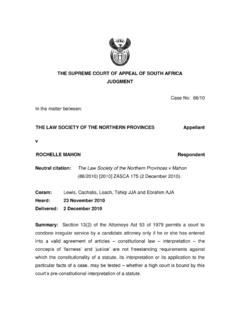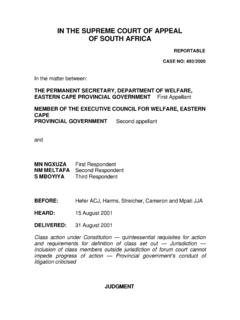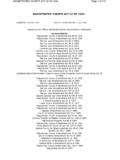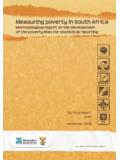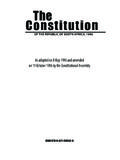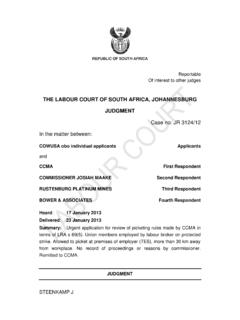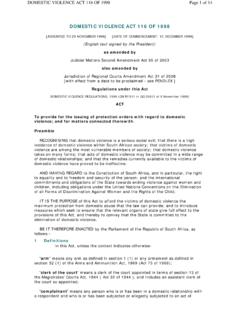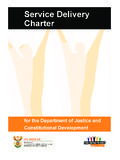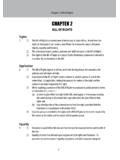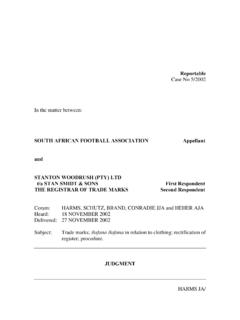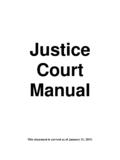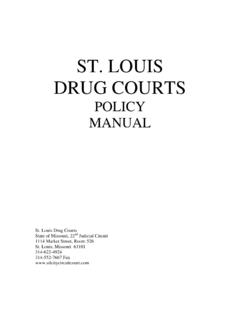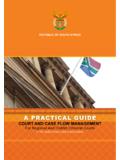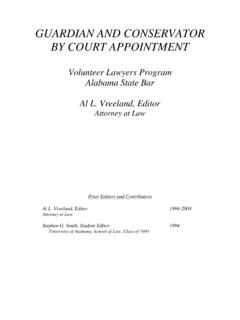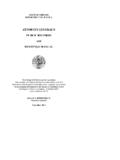Transcription of PRACTICE MANUAL OF THE LABOUR COURT OF …
1 PRACTICE MANUAL OF THE LABOUR COURT OF SOUTH AFRICA This directive comes into effect from 2 April 2013. 2 INDEX PAGE CONTENTS 1. Introduction 4 2. Application of PRACTICE MANUAL 4 - 5 3. Definitions 5 4. Compliance with the MANUAL 5 5. COURT term and recess 5 6. Dress code 5 - 7 7. Mode of address and introduction 7 8. COURT sittings 7 9. Format of legal process 7 10. Referral in terms of Rule 6 8 Default judgment 8 Case management 9 Interlocutory applications 10 Pre-trial conferences and set downs 10 - 13 Pagination, index, binding and general preparation 14 - 15 Bundles of documents prepared for trial 15 PRACTICE note 15 - 16 Roll-call 16 - 17 Continuous roll 17 Part-heard matters 17 - 18 3 Settlement agreements and draft orders 18 11.
2 Motion proceedings (excluding urgent matters) 19 Case management 19 Application to review awards and rulings 19 - 21 Applications for winding up of Trade Unions or Employers Organisations 21 - 22 Filing of answering and replying affidavits 22 Index, pagination, binding and general preparation 22 - 23 Heads of argument 23 - 24 Postponements 24 - 25 PRACTICE note in motion proceedings 25 - 26 12.
3 Urgent matters 26 - 29 13. Contempt of COURT 29 - 30 14. General provisions 30 Service 30 - 31 Settlement 31 - 32 Noting judgment 32 Striking matters off the roll 32 Ex tempore judgments 33 15. Application for leave to appeal 33 16. Archiving files 33 - 34 17. Pro bono exemption 34 18.
4 Pro- Forma documents 35 - 39 4 1. INTRODUCTION This PRACTICE MANUAL is modelled on similar manuals that apply in various Divisions of the High COURT . The MANUAL aims to promote access to justice by all those whom the LABOUR COURT serves. It is also intended to promote consistency in PRACTICE and procedure, and to set guidelines on the standards of conduct expected of those who practise in the LABOUR COURT . The PRACTICE MANUAL is not a substitute for the Rules of the LABOUR COURT . It is concerned mainly with how the Rules of COURT are applied in the daily functioning of the COURT .
5 The MANUAL tells representatives and litigants how things are done in this COURT , and what is expected of them. By their nature, the provisions of the MANUAL call for flexibility in their application where this is required to promote their purpose. The MANUAL addresses the need to maintain respect for the COURT as an institution, and to promote efficiency in the adjudication of disputes. It is hoped that the PRACTICE MANUAL will also improve the quality of the COURT s service to the public, and promote the statutory imperative of expeditious dispute resolution. 2. APPLICATION OF THE PRACTICE MANUAL This MANUAL sets out the PRACTICE to be observed in the LABOUR COURT of South Africa.
6 The MANUAL seeks to obtain uniformity amongst judges in respect of PRACTICE rulings. It must be emphasised that no judge is bound by PRACTICE directives; this MANUAL is not intended to limit judicial discretion. It should be noted though that the judges of the LABOUR COURT strive for uniformity in the functioning of the courts and their PRACTICE -related rulings. The PRACTICE MANUAL thus sets out what can be anticipated, in the normal course of events, on any issue covered by it. This MANUAL supersedes all previous PRACTICE directives issued by the Judge President. 5 Reference in this MANUAL to the Rules, is a reference to the Rules of LABOUR COURT in Government Notice 1665 14 October 1996, as amended.
7 The PRACTICE MANUAL will come into force on a date to be determined by the Judge President. 3. DEFINITIONS Day means a day other than a Saturday, Sunday or public holiday, and when any particular number of days is prescribed for the doing of any act, the number of days must be calculated by excluding the first day and including the last day. Representative means the person appearing in COURT on behalf of a party, and includes a legal practitioner as defined in the LABOUR Relations Act, 66 of 1995, and any other person who has the right to appear in the LABOUR COURT by virtue of the provisions of s 161 of the Act.
8 4. COMPLIANCE WITH THIS PRACTICE MANUAL A failure to comply with the directives contained in this MANUAL will be viewed in a serious light and will be addressed by an appropriate sanction which may include an order for costs de bonis propriis against the representative who failed to comply. 5. COURT TERMS AND RECESSES The COURT calendar year is divided into four COURT terms. The duration of each COURT term will be determined, in advance, by the Judge President. Only urgent applications will be heard during recess, except that by directive of the Judge President or the Deputy Judge President, other matters may be allocated during recess to acting judges appointed for the purpose.
9 6. DRESS CODE Representatives who appear before the COURT are required to be properly dressed. If not properly dressed they run the risk of not being seen by the presiding judge. 6 Proper dress for attorneys comprises: A black stuff attorney s gown A white shirt or blouse closed at the neck. A white lace jabot. Dark pants or skirt. Black or dark closed shoes. Proper dress for junior counsel comprises: A black stuff gown. A plain black long sleeved jacket which has both a collar and lapels. The jacket must have, for closing, one or two buttons at the waist. The buttons must be black. A white shirt or blouse closed at the neck.
10 A white lace jabot or white bands. Dark pants or skirt. Black or dark closed shoes. Proper dress for senior counsel comprises: A silk gown. A silk waist coat. A white shirt or blouse closed at the neck. A white lace jabot or white bands. Dark pants or skirt. Black or dark closed shoes. 7 Representatives who are not attorneys or advocates and who enjoy right of appearance in terms of s 161 (b) to (e) of the LABOUR Relations Act must be dressed appropriately. Men should wear a jacket, preferably with a tie. 7. MODE OF ADDRESS AND INTRODUCTION A judge must be addressed and referred to in the same manner in which a High COURT judge is addressed as either My Lord or My Lady.
